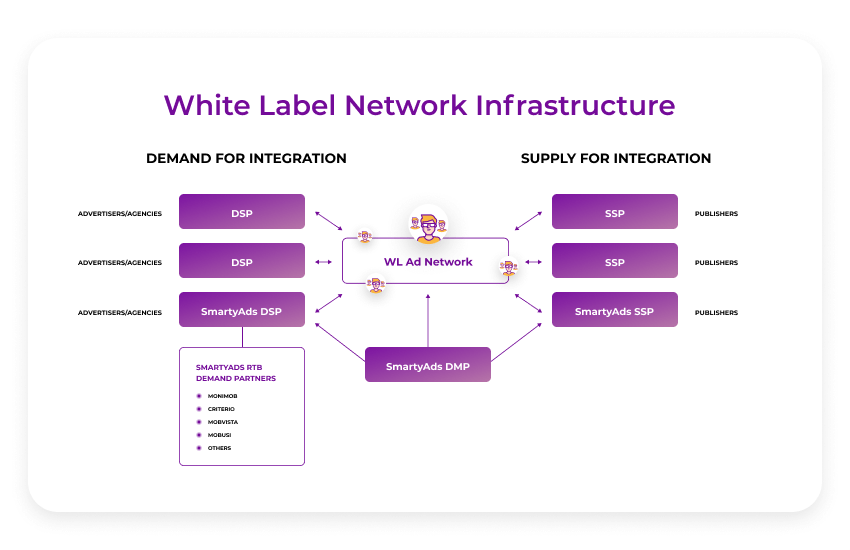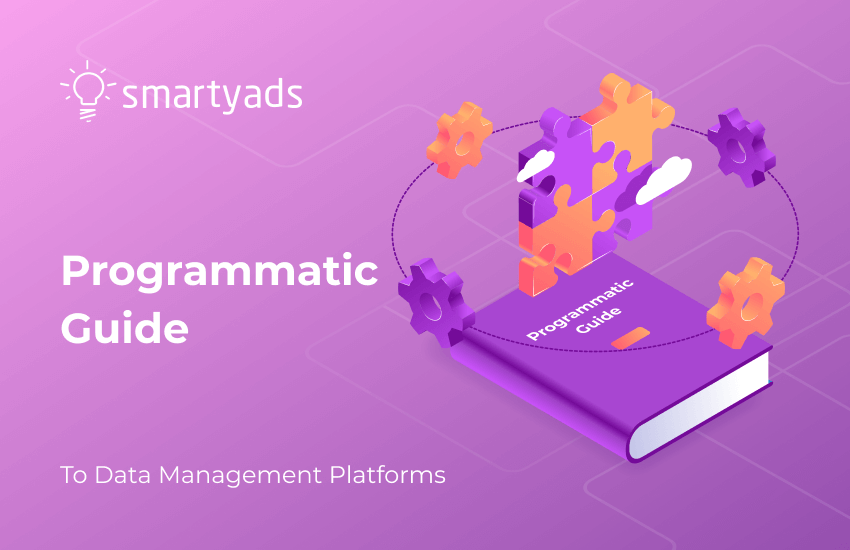Slowly but steadily, all display advertising turns programmatic. It is more effective in terms of ad revenue generation and more flexible in terms of ad campaign configurations. The dynamic of programmatic ad revenue growth suggests that these trends are closely related to the fact that publishers and advertisers today prefer to create an advertising network on their own.
The overall value of the industry, according to Online Advertising Market Research, reached $220.38 billion by the end of 2019. This means only one thing - there is plenty of fish in the sea for the supply and demand partners who want to start an ad network, set up DSP, or ad servers. Today, even the smallest businesses that want to capitalize on their own advertising model can make money in narrow programmatic digital ad niches.
What is Ad Network & How it Works
In order to start your own ad network, it is important to find out the basic principles of ad network operation. Advertising network collects and aggregates information from publishers who are interested in selling their advertising space and transfers it to the potential buyers (advertisers). When all details of the transaction are specified, the advertisement is transmitted from the network server to the website. Same way as ad exchanges, ad networks can be connected to the demand-side platform(DSP), supply-side platform (SSP), data management platforms, and analytics systems. However, there are certain differences between ad network vs ad exchange, which mostly comes down to inventory management and competition rules.

The ad network comprises the following structural elements:
On the buy-side (demand):
- Advertisers - brands and media-buyers who are interested in purchasing ad slots on different websites on a per-impression basis. In order to do this, they take part in real-time bidding, unified auctions, buy inventory from publishers directly or commission it to ad agencies.
- Agencies - representatives of the brands during media-buying campaigns that handle all questions related to campaign management.
- DSP (demand-side platform) - a programmatic media-buying software that can function either as a self-serve or managed-serve platform. It helps to adjust the parameters of ad purchases (ad budget, frequency of displaying, characteristics of the target audience, etc.) and run the campaign automatically (most often via RTB protocol).
On the sell-side (supply):
- Publishers - the media owners who present their web inventory placements in real-time bidding, header-bidding auctions, or direct programmatic deals for sale using SSP, ad exchange, or ad network.
- SSP (supply-side platform) - a programmatic software designed for media publishers that is similar to ad networks in terms of functionality, but uses a different method for inventory trading.
- Ad Network - is a platform that aggregates and accumulates available inventory placements from publishers and matches them to relevant demand from advertisers. Just like other platforms, ad network operation is based on an ad server that transacts media buys between advertisers and publishers.
The network administration side (network managers): are representatives of the platform owner who operate the ad network and choose publishers (SSP), agencies, and advertisers (DSP) to integrate into their network. They can configure the platform settings and obtain internal platform statistics considering bid requests processed, requested, impressions served, etc.
Despite the fact, that all advertising networks operate on a similar basis - transact media buys between advertisers and publishers - they also may have a lot of differences, especially if we talk about custom white-label solutions. In this case, the chosen advertising network should be able to scale rapidly and provide high-quality traffic in sufficient volumes as you connect new demand partners. It should be able to support the ad formats and the optimal payment models that help all participants meet the desired KPI.
Starting an Ad Network from Scratch
How to create an advertising network quickly? There is no such thing as quick technology creation from scratch. Unless you buy a ready-made white-label platform, you’ll have to go through all stages of work: from planning to actual platform development and maintenance.
1) Defining the pricing model
Trying to figure out which one is more profitable for all parties, don’t forget that different ad campaigns may have different objectives. That’s why usually, ad networks offer one or more of the following pricing online ad models.
- CPC (cost per click) - The amount of money that the advertiser pays per click on the ad located on the publisher’s website. Such a model works well for conversion-oriented campaigns.
- CPM (cost per thousand impressions) - The cost determined by thousand ad impressions, especially effective for raising brand exposure and awareness campaigns.
- CPV (cost per view) - The payment method in which the advertiser pays per ad view. It is typically used for video campaigns and unlike in CPM, the users initiate the view themselves.
- CPA (cost per action) - The payment model where cost is transferred for certain actions performed by users (defined by the advertiser). These actions may include clicks, purchases, installs, and other actions.
2) Defining the niche
Whom you are creating your ad network for - small or medium advertisers and publishers, those who strive to access exceptional media-trading conditions or increased safety? This all comes down to a concept that will define what kind of partners you will integrate in the future. For this reason, for instance, well-known brands like Walmart, Albertsons, Driscoll, and others united in the one blockchain-protected network aimed to enhance supply-chain efficiencies and protect each member’s proprietary data from ad fraud.
3) Defining geos and inventory types
Certain brands prefer to work only with particular ad networks whose publishers have premium inventory or who serve ads in particular business verticals or geos. Usually, being selective in terms of geos helps to ensure essential traffic quality. Opt for EU, US, Australia, and European countries and set a restriction on the type of content supported. Experts advise, 20-100 impressions are a minimum to start with if you need to build an ad network from scratch. If this task is difficult for you, try to conduct private surveys, apply questionnaires, and learn more about your audience through different channels.
4) Tech stack and resources
Building a technological stack, select a technology for real-time bidding, data processing, and ad serving to make the platform work. Ad network operation, however, demands more than technological implementation. A lot of work will be devoted to platform management and support. Ad networks such as AdSense, for instance, require advertisers to manage their targeting, bidding, and ad revenue optimization, whereas others provide such services to the clients automatically. Ad exchanges that feature in-house teams of experienced professionals have much higher chances to gain better yields since they provide additional services. Thus, they are more client-oriented.
3 essentials to start an ad network
- An ad server.
- CPM bidding algorithm, RTB bidder, integration of algorithms for targeting and retargeting, a single-point management system, other programmatic platform essentials.
- A network of publishers and advertisers.
In order to build and integrate these solutions, you need to employ machine learning engineers, data specialists, designers, QA testers and develop a project management roadmap with deadlines, according to which the work will be performed. As soon as the implementation plan is established, you know how to create an ad network technological platform. From there, the work only begins. Your in-staff professionals should be well-versed in modern ad tech tools in order to rent or build ad server and continuously configure it according to your business objectives or privacy policies.
Essential modules for publishers (SSP)
- Ad placement configuration: format, size, width, height, position, rendering methods, etc.
- Filtering options: whitelists, blacklists - blocked placement attributes, ability to disallow bids, ad categories, and demand partners.
- Separate dashboard section for available auction types: RTB, programmatic direct, private auctions (depending on platform).
- Revenue management: floor prices.
- Payment: payout system.
- Mobile inventory management: SDK.
- Analytics and reporting: bid reporting, impressions, revenue, fill rate.
- Application of the programming interface.
Essential modules for advertisers (DSP)
- Ad units configuration: format, size, width, height, position, rendering methods, etc.
- Filtering options: whitelists, blacklists - blocked publisher domains, ID, Device iD, Bundle ID, User IP, app name.
- Separate dashboard section for available auction types: RTB, Programmatic direct, private auctions (depending on platform).
- Budget and campaign management: frequency capping.
- Targeting: countries, cities, browsers, devices, IP, dayparting.
- Retargeting: audience group management.
- Conversion tracking mechanisms: pixel, postback.
- Analytics and reporting: Impressions, Conversions, eCPM, Spend, Win rate, bids, etc.
- Payment: account refills.
- Traffic safety: traffic reporting.
- Application programming interface.
| 13 Pros and Cons of building an ad network from scratch | |
| PROS | CONS |
| No commissions are given to third-party providers and external ad networks. | A substantial amount of resources: money for technology development, design, and marketing. |
| Improved customization allows you to aim for specific KPIs and enhance overall campaign performance directly. | If it’s not a white label, deployment takes a long time - from platform development to the start of the operation. |
| The ability of the technology to adjust to ever-changing market demands. | The upfront cost will be higher compared to a ready-made solution, e.g., a white label solution. |
| The chance to use the technology for your own needs or re-sell it to the brands. | Human resources: the development cycle also includes hiring or outsourcing engineers, developers, data specialists. |
| Numerous integration opportunities with another ad tech. | No guarantee that a ready-made solution will stand in line with other options. |
| Ultimate transparency and safety. | Difficult to compare the prices for development with competitors. |
| Increased traffic safety control. Protection from data breaches. Data ownership. | The long and energy-consuming decision-making process at every stage of platform development. |
| Scaling up the platform will demand additional investments in the future. | |
| After development is completed, the platform will demand licensing. | |
How to Build an Ad Network with SmartHub
Now, let’s find out how to build an ad network with a white label solution. There is a common misconception that you may pioneer the business niche only in case you build everything from scratch. It is only partially true. With a white label solution, you purchase a configurable platform that is ready to be activated and needs only minor design adjustments.
This way, YouTube once purchased Adobe platform back in 2006. After a while, Google acquired Youtube platform for serving video ads. The company spent neither enormous budgets nor too much time with the technological solution they customized according to their objectives. The same thing is happening with advertising technologies. Now you can buy technologies like white label ad server, and white label bidder separately or purchase a ready-made fully-served solution like SmartHub white label ad exchange solution which is a ready-made platform connected to an ad server.
How to start an ad network with SmartHub. SmartHub platform is a fully developed and supported programmatic solution for advertising network creation and management that can be configured and scaled anytime. Just like white label DSP or white label SSP, white label ad network comes as a pure technology without label, logo or brand name.
The first stage of platform adjustment includes general platform customization. The owner sets up supply and demand-side endpoints, global blacklists, traffic targeting settings, billing section for partners, and other configurable platform parameters according to the manual. Then, the endpoints for demand partners are generated and transferred to the supply parties so that the media-trading process could be put into action. During the process of trading, the client can obtain and manage internal platform statistics: a number of bids, processed, impressions served, etc.
With white label solution you can build your own programmatic business on white label ad network that:
- Meets the highest industry technological standards.
- Is fully compliant with GDPR.
- Enables omnichannel advertising for all platforms and ad formats, including the most trending - mobile, video, native, display, and CTV.
- Offers the most precise targeting (when integrated with DMP or CDP).
- Gathers the best innovative advertising technologies that boost the yield of publishers, and the profit of advertisers.
- Provides analytics in real-time that facilitates taking informed decisions quickly.
- Deeply integrates into the programmatic network and has own programmatic infrastructure (DSP, SSP, Ad exchange).
- Focuses on brand safety, by building in-house traffic scanning tools and connecting to the Forensiq and other traffic safety providers.
- Offers qualified support with a team experienced in programmatic since 2013.
The takeaway thought
These days anyone can create own advertising network. You should only decide which model suits you best - a new solution or a ready-made white-label platform. With white label solution, there’s no need to reinvent the wheel and put all your money and time into development, design, support, and building connections with the advertising world. Sure thing, white label solution may seem like a costly investment. However, it quickly pays off in the long run and helps to avoid losses associated with the unstable work of the newly-developed solution. More importantly, if you create an ad network based on the white label technology, you launch it immediately, while your competitors waste several years on building their platforms from scratch.

.webp)


